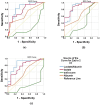Prognostic significance of lactate/albumin ratio in respiratory failure and sepsis
- PMID: 40130722
- PMCID: PMC11938314
- DOI: 10.1080/07853890.2025.2482024
Prognostic significance of lactate/albumin ratio in respiratory failure and sepsis
Abstract
Introduction: Prognostic markers like SOFA and APACHE-II scores for sepsis and acute respiratory failure (ARF) are often complex for routine use. This study evaluated the lactate-albumin ratio (LAR) as a prognostic marker for in-hospital outcomes, mechanical ventilation, and inotrope requirement.
Methods: A prospective cohort study was conducted among ICU and Internal Medicine Unit patients at Manipal Teaching Hospital, approved by the Institutional Review Committee (approval number IRC/MCOMS/584). Arterial samples for ABG values (lactate, PaO2, PaCO2, HCO3, and FiO2) and venous samples for albumin, bilirubin and creatinine were collected on admission. Arterial lactate, serum albumin, LAR and SOFA scores were recorded and compared with in-hospital outcomes. Statistical analyses were performed using SPSS version 25, with ROC-AUC for assessing prognostic markers (LAR, lactate alone) and Delong's test for comparison.
Result: Among 115 sepsis cases, ROC-AUC of LAR for in-hospital mortality (cut-off 1.78), mechanical ventilation (1.28), and inotropes (1.07) were 0.914, 0.881, and 0.819, respectively. Among 99 ARF cases, ROC-AUC for mortality (1.98), ventilation (1.10), and inotropes (1.18) were 0.878, 0.958, and 0.876. Among 43 sepsis + ARF cases, ROC-AUC for mortality (2.14), ventilation (1.20), and inotropes (1.20) were 0.853, 0.874, and 0.849.
Conclusion: The lactate-albumin ratio was a better prognostic marker than albumin alone and SOFA score for predicting in-hospital mortality, need for mechanical ventilation and inotropes in sepsis, ARF and combined Sepsis and ARF patients whereas it was statistically equivalent to lactate alone in predicting in hospital outcome. Lactate-albumin ratio also indicated disease progression, where an increase in cut-off value was seen with progressed or severe disease.
Keywords: ARF; LAR; Lactate; albumin; hospital-outcome; mortality; predictor; sepsis.
Conflict of interest statement
No potential conflict of interest was reported by the author(s).
Figures



Similar articles
-
[Early lactate/albumin ratio combined with quick sequential organ failure assessment for predicting the prognosis of sepsis caused by community-acquired pneumonia in the emergency department].Zhonghua Wei Zhong Bing Ji Jiu Yi Xue. 2025 Feb;37(2):118-122. doi: 10.3760/cma.j.cn121430-20240709-00577. Zhonghua Wei Zhong Bing Ji Jiu Yi Xue. 2025. PMID: 40017357 Chinese.
-
Lactate-to-albumin ratio as a potential prognostic predictor in patients with cirrhosis and sepsis: a retrospective cohort study.BMC Infect Dis. 2025 Feb 14;25(1):223. doi: 10.1186/s12879-025-10601-6. BMC Infect Dis. 2025. PMID: 39953385 Free PMC article.
-
[Establishment and validation of a sepsis 28-day mortality prediction model based on the lactate dehydrogenase-to-albumin ratio in patients with sepsis].Zhonghua Wei Zhong Bing Ji Jiu Yi Xue. 2024 Nov;36(11):1140-1146. doi: 10.3760/cma.j.cn121430-20231012-00865. Zhonghua Wei Zhong Bing Ji Jiu Yi Xue. 2024. PMID: 39697017 Chinese.
-
Relative efficacy and safety of early lactate clearance-guided therapy resuscitation in patients with sepsis: A meta-analysis.Medicine (Baltimore). 2019 Feb;98(8):e14453. doi: 10.1097/MD.0000000000014453. Medicine (Baltimore). 2019. PMID: 30813144 Free PMC article. Review.
-
Lactate-enhanced-qSOFA (LqSOFA) score as a predictor of in-hospital mortality in patients with sepsis: systematic review and meta-analysis.Eur J Trauma Emerg Surg. 2025 Jan 24;51(1):33. doi: 10.1007/s00068-024-02757-8. Eur J Trauma Emerg Surg. 2025. PMID: 39853387
Cited by
-
Red cell distribution width and clinical outcomes in sepsis patients infected with Escherichia coli using data from MIMIC-IV.Eur J Med Res. 2025 Jul 5;30(1):580. doi: 10.1186/s40001-025-02756-4. Eur J Med Res. 2025. PMID: 40618111 Free PMC article.
-
Prevalence and Clinical Impact of Obstructive Sleep Apnea in Patients with Severe Aortic Stenosis Undergoing Valve Replacement.Biomedicines. 2025 May 21;13(5):1252. doi: 10.3390/biomedicines13051252. Biomedicines. 2025. PMID: 40427082 Free PMC article.
References
MeSH terms
Substances
LinkOut - more resources
Full Text Sources
Medical
Miscellaneous
